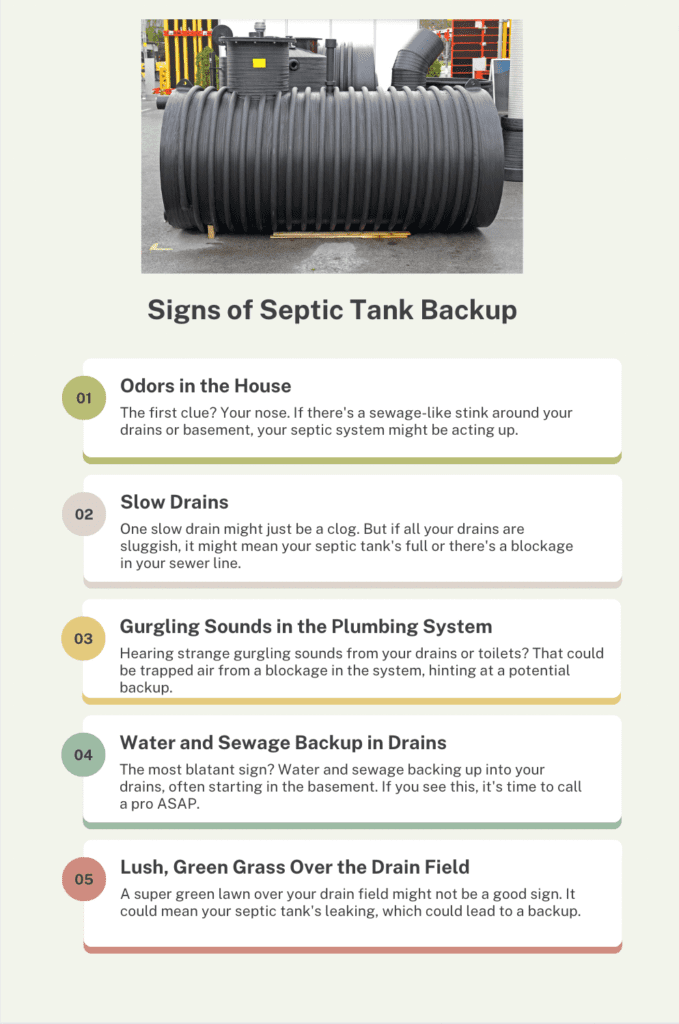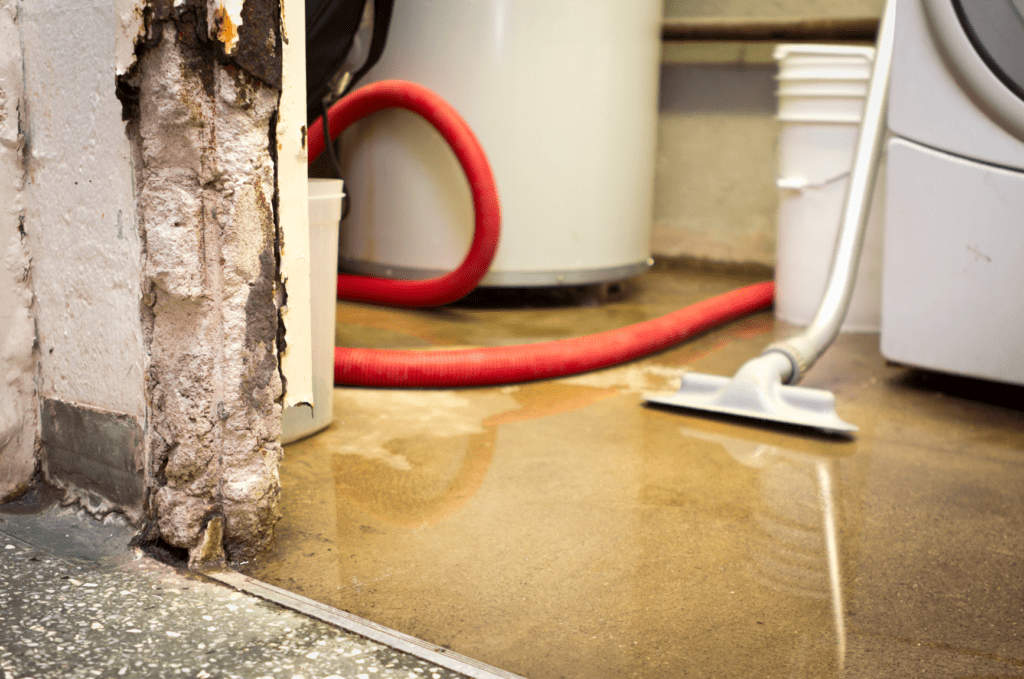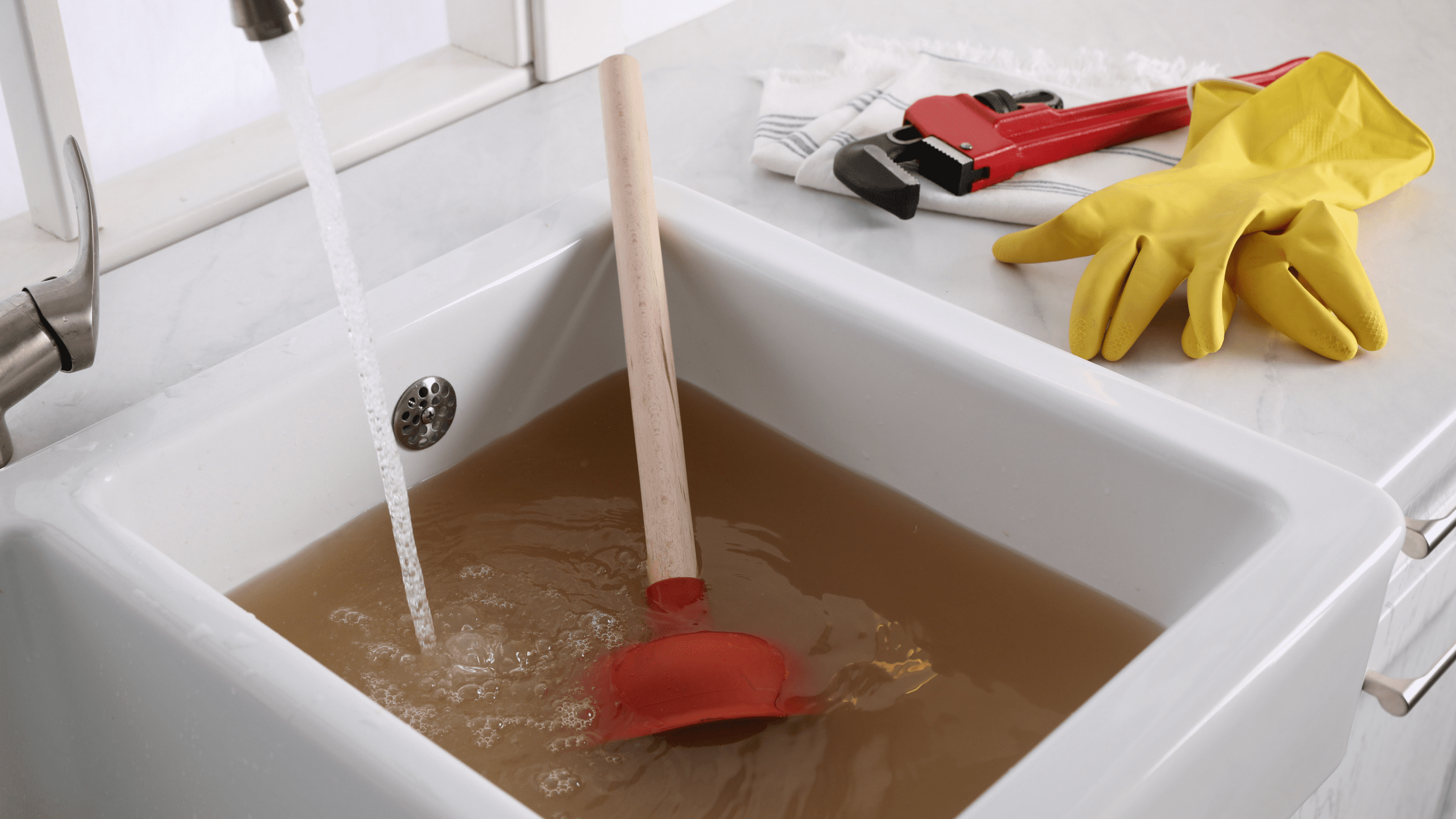Like anything else, septic tanks can have a few hiccups. Take care of your septic tank, and it’ll take care of you for decades. Neglect it, and you might find yourself in a stinky situation.
Speaking of stinky situations, let’s talk about septic tank backups. This isn’t just a minor hassle, it’s a serious issue.
Imagine untreated sewage flowing the wrong way, straight into your home. Yuck! It’s a recipe for hefty property damage, unexpected expenses, and health hazards from all those nasty germs.
So, in this blog post, we’re going to dig deep into the world of septic tanks. We’ll talk about what makes them back up, and how to keep that from happening.
Stick with us as we navigate this must-know topic for every proud septic tank owner!
Causes of Septic Tank Backup
Alright, let’s get to the bottom of what causes septic tank backups. Knowing this can be a game-changer in avoiding this headache. Here are the usual suspects:
Overuse of Water
Septic tanks can only handle so much. If you’re having marathon shower sessions, running the dishwasher all the time, or doing laundry for an army, you might overwhelm it. And that’s when backups can happen.
Skipping Maintenance and Pumping
Your septic system needs a little TLC to stay healthy. Regular pumping, every 3 to 5 years depending on your household size, is a must. If you skip it, solids pile up, and you’ve got a potential backup on your hands.
Clogged or Blocked Drain Field
Your drain field plays a big role in treating wastewater. But it can get clogged by solids or too much surface water. When that happens, the wastewater’s got nowhere to go and might just end up back in your house.
Tree Roots Intrusion
Trees love the goodies in your septic system, and their roots can invade, messing up your pipes. This can trigger backups and a whole bunch of other problems.
Heavy Rains and Flooding
When it pours, your drain field can get waterlogged, making it hard to disperse wastewater. This can force water to back up into your septic tank, and yes, into your home.
Old and Worn-Out Septic Systems
Like anything, septic systems get old and can start to break down. If you’ve got an old tank or one that hasn’t been well cared for, things can go wrong, including backups.
Knowing these causes helps you keep your septic system in check. Coming up next, we’ll talk about how to spot a septic tank backup, so you can nip it in the bud before it gets worse.
Signs of Septic Tank Backup

So, you’re wondering how to spot a septic tank backup? Well, here are some telltale signs that something’s off with your septic system.
Odors in the House
The first clue? Your nose. If there’s a sewage-like stink around your drains or basement, your septic system might be acting up.
Slow Drains
One slow drain might just be a clog. But if all your drains are sluggish, it might mean your septic tank’s full or there’s a blockage in your sewer line.
Gurgling Sounds in the Plumbing System
Hearing strange gurgling sounds from your drains or toilets? That could be trapped air from a blockage in the system, hinting at a potential backup.
Water and Sewage Backup in Drains
The most blatant sign? Water and sewage backing up into your drains, often starting in the basement. If you see this, it’s time to call a pro ASAP.
Lush, Green Grass Over the Drain Field
A super green lawn over your drain field might not be a good sign. It could mean your septic tank’s leaking, which could lead to a backup.
Health of Nearby Water Sources
Have a private well or live near a pond or stream? Keep an eye on them. If your septic tank’s failing, it could contaminate these water bodies. Unusual algae growth or dying aquatic life could be a clue.
Spotting these signs early and acting fast can help dodge a full-blown septic tank backup. Up next, we’ll discuss the fallout of septic tank backups and why it’s crucial to prevent them.
Consequences of Septic Tank Backup in the House
Septic tank backup is more than just a messy problem—it can come with some serious fallout. Let’s break down what can happen.
Health Risks
A septic tank backup can be a health hazard. Here’s why:
- Exposure to Nasty Bugs: Raw sewage is a cocktail of harmful bacteria, viruses, and parasites. These can cause anything from stomach bugs to Hepatitis A. Not fun.
- Allergies and Breathing Problems: Mold and mildew love damp places, like a house after a septic backup. These can set off allergies or even asthma attacks.
Property Damage
The damage to your home can be significant. Here’s what can happen:
- Damage to Your Home: Wastewater from a backup can damage your home’s foundation, walls, and floors. And fixing that? Not cheap.
- Destroyed Belongings: Anything that touches the sewage might need to be tossed out to keep your home safe.
Financial Implications
A septic tank backup can also hit your wallet hard:
- Cleanup and Repair Costs: Cleaning up after a backup isn’t a DIY job. Pros need to handle it, and they don’t come cheap. Neither does repairing your home or replacing ruined items.
- Lower Property Value: Serious damage from a backup, or a poorly maintained septic system, can bring down your property’s value.
All this shows why it’s so important to keep your septic system in good shape and act quickly if something seems off. Next up, we’ll talk about how to prevent septic tank backups.
Preventing Septic Tank Backup
Preventing a septic tank backup is a lot less hassle than dealing with one. So, let’s talk about some tips to keep your system running smoothly.
Regular Maintenance and Inspection
Like a car, your septic system needs regular check-ups. Pump your tank every 3-5 years, depending on your household size and tank size. And get a pro to inspect it regularly. They can spot problems before they turn into disasters.
Be Smart About What You Flush
Remember, your septic system isn’t a trash can. The only things you should flush are human waste and toilet paper.
Things like wipes, sanitary products, and diapers can clog your system. And too much grease? That’s a no-no. In the kitchen, compost food scraps instead of using the garbage disposal.
Use Water Wisely
Your septic system can only handle so much water. Try to spread out your water use throughout the day and week.
Don’t run the dishwasher and washing machine at the same time. Spread out your laundry loads. And consider water-efficient appliances and fixtures to cut down on water use.
Protect the Drain Field
Your drain field is a vital part of your septic system. It disperses wastewater into the soil. So, keep trees and large shrubs away—they can damage the system with their roots.
And don’t drive or park heavy vehicles over it. That can compact the soil and damage the pipes.
By following these tips, you can help prevent a septic tank backup and keep your system running for a long time. But if you do end up with a backup, it’s important to know what to do. We’ll cover that next.
What to Do When a Septic Tank Backs Up

Despite your best efforts, there might come a time when you’re faced with a septic tank backup. If this happens, it’s important to act quickly to minimize damage and health risks.
Here are the steps you should take:
Immediate Steps to Take
- Stop Using Water: To prevent further backup, stop all water usage in your home. This includes sinks, showers, washing machines, dishwashers, and toilets.
- Evacuate Affected Areas: If sewage has backed up into your home, evacuate these areas to avoid exposure to harmful pathogens.
- Ventilate the Area: If possible, open windows and doors to reduce odors and dissipate harmful gases that can be present in sewage.
- Notify Professionals: Contact a septic tank professional as soon as possible. They’ll be able to diagnose the issue and guide you on the next steps.
Restoration and Cleanup Process
Once the immediate crisis is addressed, the cleanup and restoration process can begin. This typically involves:
- Professional Cleanup: A professional cleanup crew will use specialized equipment to clean and sanitize affected areas. They will also dispose of contaminated materials according to local regulations.
- Damage Assessment and Repairs: After the area is cleaned, you’ll need to assess any damage to your home’s structure and belongings. Some items may need to be replaced, while others can be cleaned and restored.
- Preventing Future Issues: Lastly, work with a septic system professional to address the cause of the backup and take steps to prevent future issues. This might involve repairs to the septic system, changes in your water usage habits, or modifications to the landscape around the drain field.
Conclusion
Maintaining a septic tank is crucial to avoid backups and subsequent damages. Causes of backup include overuse of water, neglected maintenance, blocked drain fields, and old septic systems.
Spotting early signs of backup like odors, slow drains, and gurgling sounds can prevent a full-blown crisis. Regular maintenance, smart water usage, careful disposal, and drain field protection are key prevention strategies.
If a backup occurs, immediate professional assistance can mitigate damage and health risks.

